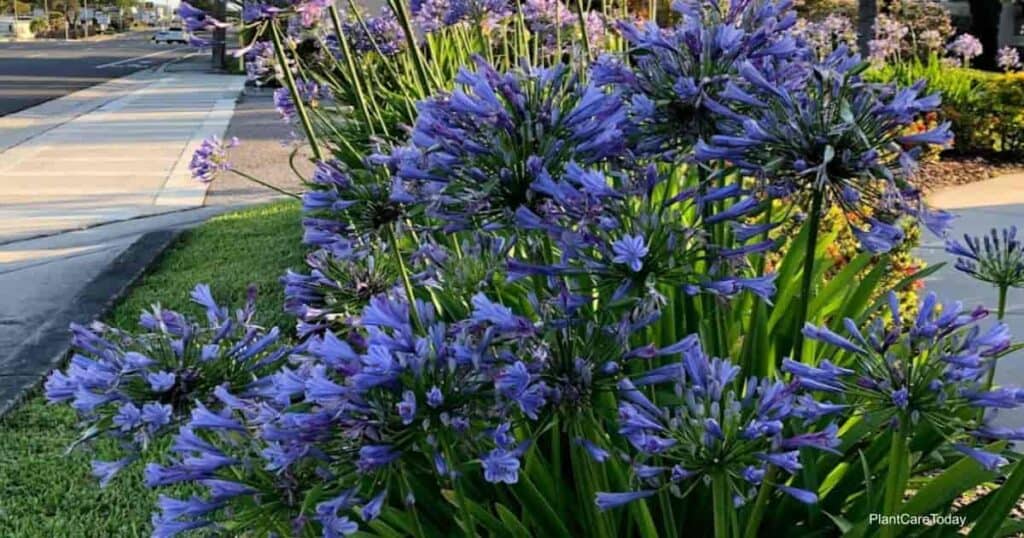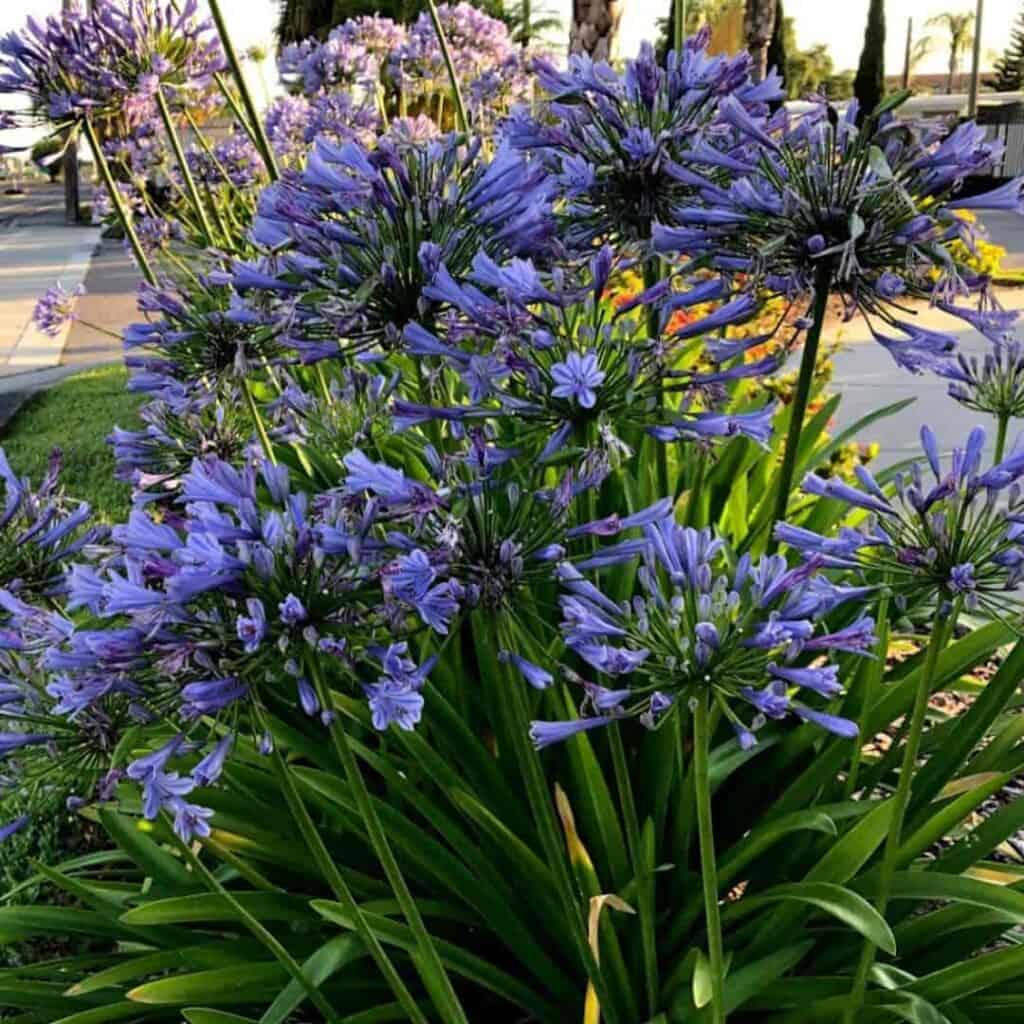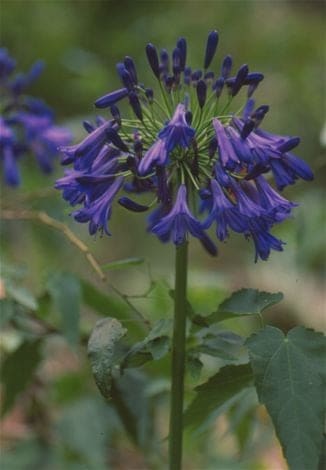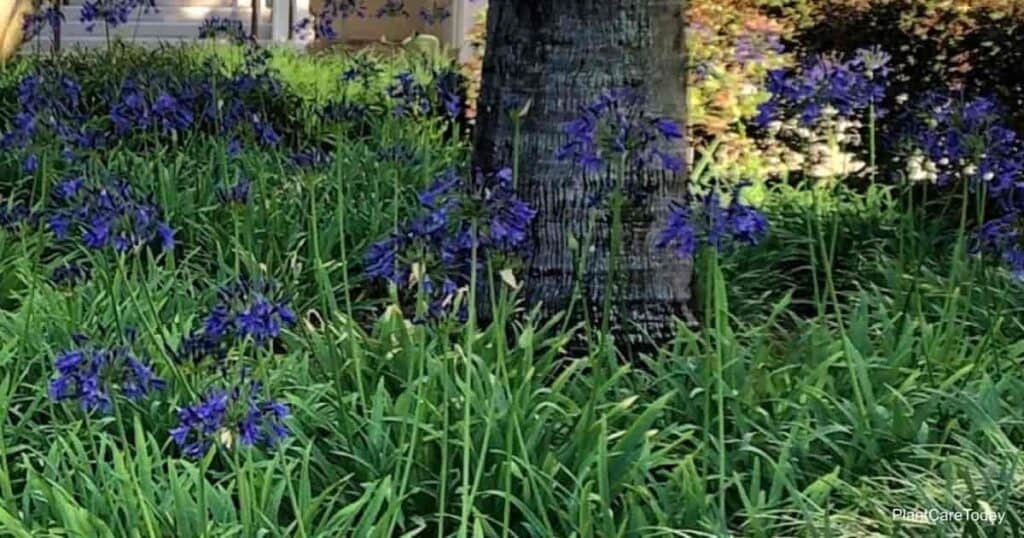Who doesn’t love the blue flowers of the Agapanthus plant?
Agapanthus is the name of the genus for the exotic blue African Lily of the Nile. These showy perennials, native to Southern Africa, hold a strange beauty.

The genus Agapanthus was established by L’Heritier in 1788. Formerly of Liliaceae (lily family), it now resides in the Amaryllidaceae family and the subfamily Agapanthoideae.
Agapanthus Quick Care Tips
- Botanical Name: Agapanthus africanus
- Common Name(s): Lily of the Nile, African Lily
- Synonyms: Agapanthus praecox, Agapanthus umbellatus
- Family & Origin: Amaryllidaceae family, native to South Africa
- Growability: Easy to grow
- Grow Zone: USDA zones 8-11
- Size: Grows up to 3-5 feet tall and wide
- Flowering: Blooms in summer with blue or white flowers
- Light: Full sun to partial shade
- Humidity: Tolerates low humidity
- Temperature: Tolerates temperatures down to 20°F
- Soil: Well-draining soil
- Water: Water regularly, but do not overwater
- Fertilizer: Fertilize once a month during the growing season with a balanced fertilizer
- Pests & Diseases: Susceptible to aphids, spider mites, and root rot
- Propagation: Propagated by division or from seed
- Plant Uses: Used as a border plant, in containers, or as a cut flower.
The Debut Of The African Lily
The beginning of agapanthus care started in Europe during the late 1600s with Agapanthus africanus (“ag-ah-PAN-thus af-ri-KAY-nus”), a native of the Cape of Good Hope in South Africa.

The bulbs have traveled the world and become naturalized in the UK, United States, Jamaica, Mexico, and Australia.
Agapanthus africanus was the first of the Agapanthus genus to reach the U.S., where it made a striking debut.
Africanus may be the least hardy of the evergreen species, with its lavender-blue flowers rising above basal strap-like leaves. Common names include:
- African Lily
- Blue African Lily of the Nile
Two Groups of Agapanthus – Evergreen and Deciduous
The Agapanthus blue can be divided into two groups: Four plant species which are evergreen, and six deciduous species.

South Africa is the only place Agapanthus occurs naturally.
The name Agapanthus comes from the Greek agapé, love, and anthos, flower, translating to “flower of love.”
Generally, most people think of Agapanthus bulbs. In fact, they may be listed in catalogs under bulbs. However, these perennials are not bulbs; they have thick, fleshy roots.
Most of these blue perennials, known by the common name of “Lily of the Nile,” would be considered hardy for planting in the ground. In USDA Zones 7 to 10 – new Agapanthus varieties are extending that range.

In locations colder than USDA Hardiness Zone 7, grow Agapanthus plants as potted plants.
Agapanthus Blue Plant Care
All too often, if a plant is hardy and easy to grow, it can find itself overused or not considered for use since it could be so “common.”
Many homeowners search for something new – get bored or lack excitement for a bloomer possibly found “next door.”
Agapanthus ‘Blue Yonder’

- Prolofic summer bloomer from July-September
- Dense, showy clusters of intense cobalt blue star flowers starting after the last spring frost
- Cold hardy Zones 5-10
- Full to partial sun
- Perennial, deciduous
- Great selection for borders and beds, makes an excellent container plant
Agapanthus plants, like so many other excellent landscape flowering plants, are a charmer when grown, used, and presented right. They make a fantastic accent plant.

[easy-tweet tweet=”Agapanthus plants, when grown, used and presented right… they are a charmer.”]
Size & Growth
One of Agapanthus’s finest assets is its flowering. Flower colors of deep blue, and violet to white flowers, show themselves from these summer bulbs in mid to late summer and, in some areas all, the way into October.
Plants also can be deciduous or evergreen, short or tall, variegated or solid green leaves, along with open flowers or dense, tight heads.

No matter the size, the agapanthus flower stalks always appear to be weighed down by the “heavy” flower clusters sitting atop them. The deciduous Agapanthus species:
- Agapanthus campanulatus
- Agapanthus caulescens
- Agapanthus inapertus
… are generally considered hardier and should rest for the winter.
The true wild species evergreen agapanthus is known as a difficult plant to grow.
However, one of the cultivars is the well-known dwarf Agapanthus ‘Peter Pan,’ 18″ inch stems with medium blue flowers.
Many of the agapanthus varieties today contain the word “Blue,” which is more of a color range of dark lavender to light blue.
Some of the darkest hybrids can be almost navy blue resulting from crosses with Agapanthus inapertus.
There are several white agapanthus cultivars available.

According to PlantzAfrica.com (South Africa National Biodiversity Institute) – “Many gardeners and even some authors of publications mistakenly call the agapanthus in cultivation Agapanthus africanus. This is almost certainly incorrect. Agapanthus africanus is a winter rainfall plant and is difficult to cultivate, needing very well-drained soil, hot, dry summers, and wet winters. Practically all the evergreen agapanthus in cultivation worldwide are hybrids or cultivars of Agapanthus praecox.”
Eye-Catching Blue Flower
In appearance, the foliage of Agapanthus looks much like amaryllis. The bloom stalk of tall stems, sometimes 3′ feet high, is topped with clumps (umbel) of 20 to 30 showy bright blue funnel-shaped blooms, eye-catching and long-lasting.

To keep these plants with their splendid flowers blooming freely, divide the evergreen varieties every 3 to 4 years.
Deciduous varieties should just be left alone, even in pots where they grow well when crowded.
Light & Temperature
In areas where summer heat is intense, grow the plants in partial shade; otherwise, keep them in full sun.

In USDA growing climate Zones 8 through 11, Agapanthus can stay in the ground all year. In Zone 8 and the warm areas of Zone 7, mulch is a smart idea.
When growing in northern zones moves, plants in containers are back outside after the last threat of frost passes.
Watering and Feeding
Agapanthus loves water and should not be allowed to dry out in summer. Where it is colder, these make nice house plants in large pots.
When the growing season starts, fertilize with a balanced fertilizer and keep the soil well-watered.

Soil Type & Transplanting
Plant Blue Lily-of-the-Nile Agapanthus at a depth of 2″ – 3″ inches in rich soil, well supplied with humus.
When you plant in container varieties like Agapanthus blue yonder, it likes fertile, moist, and well-drained soil rich in compost or organic matter.
Agapanthus ‘Storm Cloud’

- Huge heads of deep blue flowers
- Flowers appear in June, July, and August
- Clumping perennial, use in containers or mass bed.
- Zones 7-10
- Easily over-wintered in cooler climates
- Likes fertile, well-drained sandy soil
- Prefers partial sun to full sun
Grooming And Maintenance
Deadhead to encourage more flower buds and prevent plants from going to seed.

How To Propagate Agapanthus
Divide clumps every 3-5 years in spring, remove offsets, and replant them.
The deciduous Agapanthus varieties should be divided in March. The evergreen types should be divided after flowering.
Step for Dividing Agapanthus Plants

Agapanthus plants are easy to divide. Follow these steps:
- Use a garden fork starting from the outside edges of the plant to remove the root ball.
- Cut off old flower stems at the base
- Remove damaged or faded leaves
- Cut large clumps into smaller clumps using a sharp knife or hand pruners.
- Prune back dead roots and foliage by 2/3 before replanting.
- Plant new divisions in well-draining soil in a sunny location.
- Keep new plants well watered.
- NOTE: Smaller divisions or clumps take longer to bloom.
More on Dividing Agapanthus Bulbs
Agapanthus Pests or Diseases
Slugs and snails chew leaves; otherwise, nothing major

Suggested Uses to Plant Agapanthus Flowers
Agapanthus makes a wonderful addition to a flower border. Check out some of the new dwarf Agapanthus varieties at your local nursery.
Grow plants in containers or tubs for effective, bold accents. Group them in front of a hydrangea or pink Belladonna lily. Combine with Alstroemeria, white Crinum asiaticum, or Coreopsis.
Agapanthus attracts bees, butterflies, and hummingbirds.
Dry the seed heads for use year-round in dried arrangements.

Agapanthus “African Lily” Facts
- Origin: South Africa
- Family: Amaryllidaceae, subfamily Agapanthaceae (agapanthus family)
- Common Name: Blue African Lily of the Nile, African lily
- Plant Type: herbaceous perennial
- Height: Depending on variety – 18 inches to 5 feet
- Leaves: Lance or strap-shaped, narrow to broad, gray-green to medium green shiny leaves
- Flowers: Fragrant, Dark blue through white, Upright, bell-shaped, tubular, and pendulous. Make excellent cut flowers
- Bloom Time: Mid-summer through October
- Hardiness: Outdoor USDA Hardiness Zones 8 through 11
- Exposure: Full sun, partial shade in hot summer areas
- Soil: Rich, well-drained, lots of organic material
- Water: During active growth, moderately heavy
- Fertilizing: Fertilize in spring with a balanced fertilizer
- Propagate: In spring, propagate by division – growing agapanthus from seed is possible but rarely by homeowners
- Pests & Problems: Slugs and snails chew leaves
Images: Blue Yonder – AG 3 | Storm Cloud – AG 3
